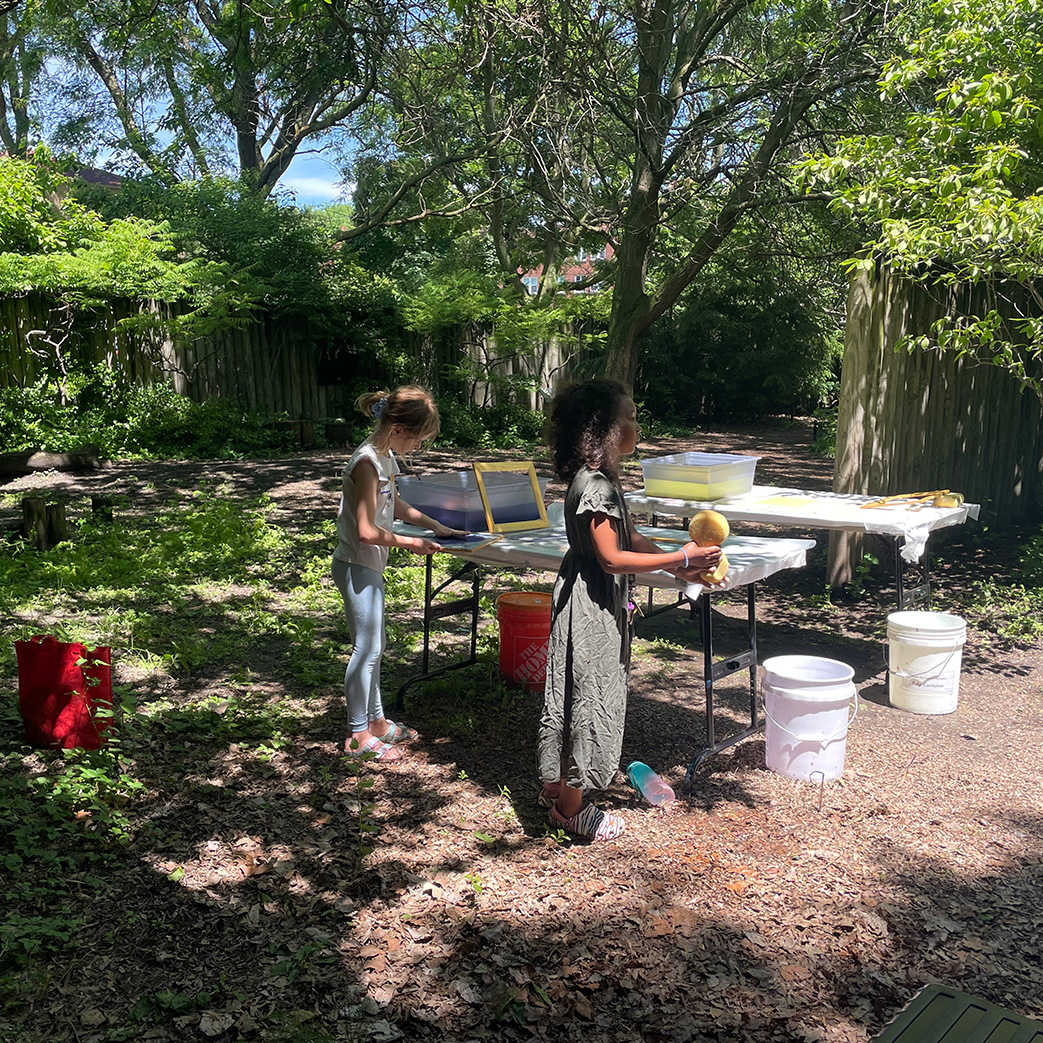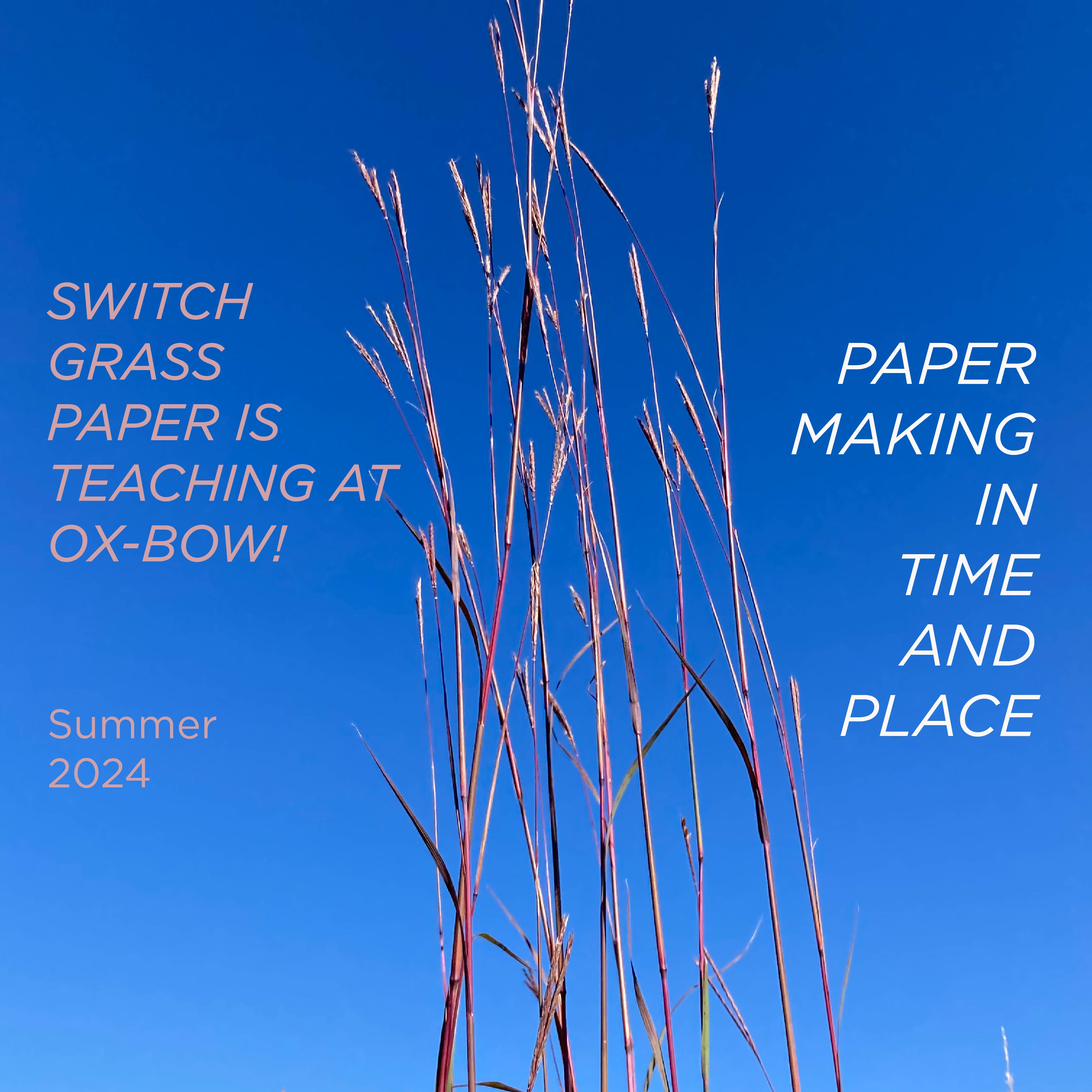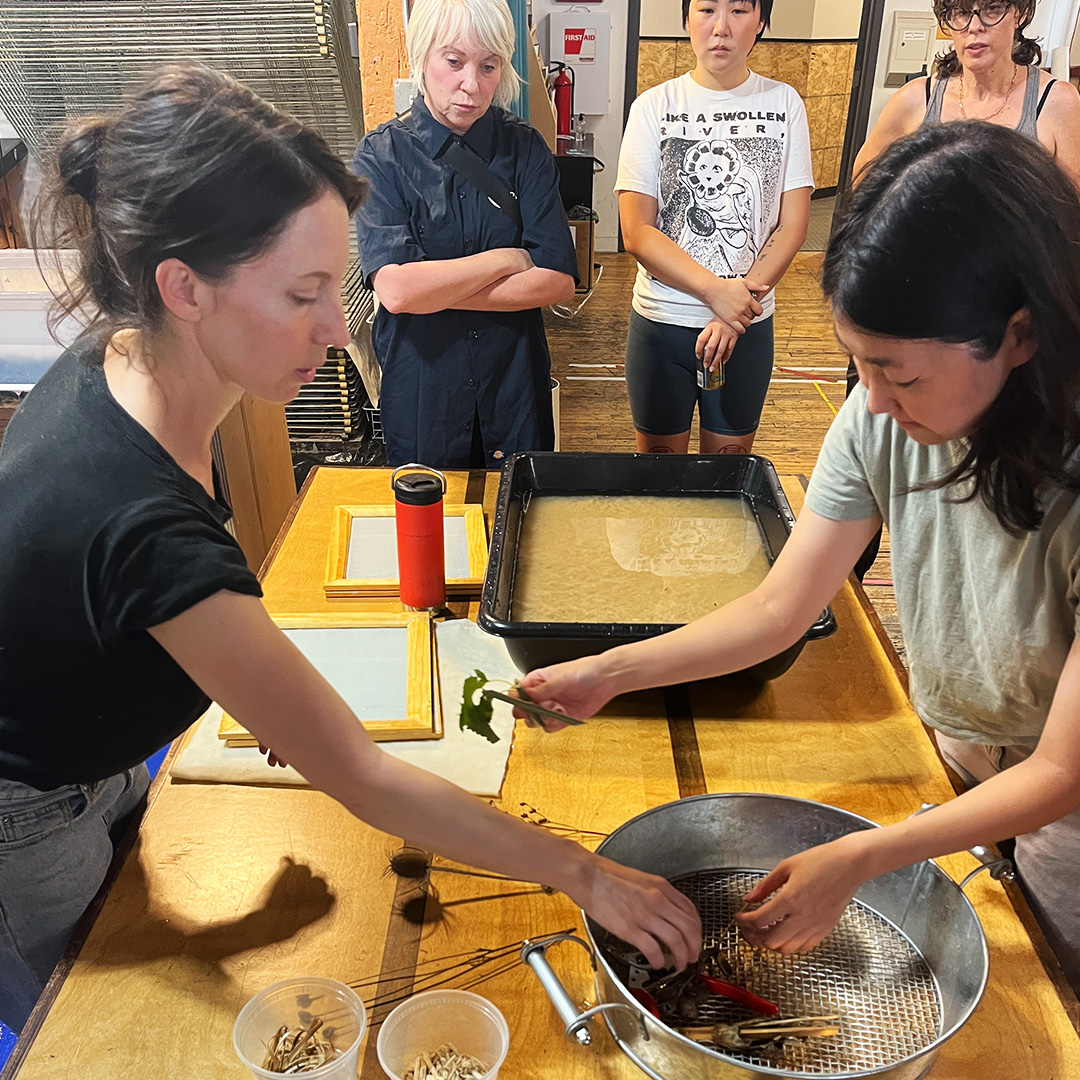Switch Grass Blog
2024 Recap

Switch Grass is currently on break as we plan for 2025. 2024 was a busy and productive year for us. We hosted 7 public workshops across Chicago with the Chicago Parks District and the Chicago Public Library, and we hosted 2 private workshops in Megan’s yard in Bridgeport. The yard had long afforded us a space to experiment with new techniques and materials and we were sad to see it go, but we will be looking at new spaces to move into next year and beyond.
In addition, we co-taught a one-day class at Northwestern University with Allison Wade and spent a week teaching at Ox-Bow in Saugatuck, MI. During the past month, Aya traveled to Echizen in Fukui prefecture, Japan to practice making washi and to learn more about the process from several washi makers, including National Living Treasure Iwano Ichibei. Making paper in community with others has been deeply gratifying and we thank you for coming along this journey with us.
We will be researching funding opportunities to support more public-facing workshops next year. Please feel free to reach out with suggestions.
Workshop at Northwestern University January 2024

Allison Wade is a friend, artist, and professor at Northwestern University in Evanston. She was teaching a winter class on iteration as sculptural strategy, and invited us to do a one-day papermaking workshop.

We proposed a workshop that would cover basic papermaking, embedding, and other paper manipulation techniques, and asked the students to bring in their own materials to embed. We had a great time–once we covered the basics and made some suggestions for embedding, shaping, layering, creating negative space, etc., they took off running.
One student embedded a black and white portrait photo, securing the photo in place by pressing white cotton pulp around its edges. Another student sandwiched twine between two layers of pulp so that the material made a double-sided relief on the paper. Yet another embedded string and wire mesh into layers of pulp, creating a honeybee whose wings could be bent away from the paper.
We held the workshop in a classroom so it got fairly wet, but we mopped periodically and got some help from the students near the end. Allison stretched a pressed and fairly stable sheet over a roll of tape, which dried into a beautiful shape reminiscent of a ghost.
Washi Winter 2024

Washi is Japanese paper made of Kozo, or paper mulberry. It is called Hanji in Korean, and both the paper and technique came from Korea via the Buddhist monk Damjing in 610 CE. We wanted to learn and teach the process of making this paper, so we jumped right in.
We bought dried Kozo and Mitsumata from Carriage House Paper in NYC, measured 0.5lbs of each type of fiber and soaked them in water for a few days. We then cooked the fibers together for over four hours in a solution of water and soda ash, let the entire thing cool, and washed the fibers in fresh water to get rid of the soda ash.
The next step was chiri-tori, or removing the chiri/imperfections from the long fiber strands. The photo shows us in the middle of this process, suspending the strands in water and going through them one at a time, picking out the chiri by hand.
We then took our wooden mallets and beat the cleaned strands on cheesecloths that we placed on the asphalt outside of Megan’s garage. The cheesecloth prevented a lot of the fiber from ending up on the sidewalk (which did happen–and incidentally dried into paper strips that Megan peeled off some days later). Some workshops will beat the fibers over a couple of days or over the course of an entire day. We did not do this, and the result was a rougher, less silky sheet of paper.
Regardless, we were able to suspend our beaten fibers in water, and added formation aid to slow down the drainage and add “conditioner” to the fibers, allowing them to move more freely over each other. Pulling the paper (kami-suki) was a challenge, and it took some time to figure out how to scoop into the water multiple times and to agitate the sugeta (the Japanese version of a mold and deckle) so that the fibers spread evenly over the surface of the su.
Nevertheless, we were able to make a stack, press it, peel the sheets away from one another, and brush them onto wooden boards to dry.
Our conclusion is that repetition and attention to detail will help us improve over the long run. Each step in the process affects the next, and in order to create a flawless sheet of paper, we will need to revisit each part again and again. The entire process is riveting and oddly addictive.
Watermarks May 2024

We wanted to experiment with watermarks–what materials could be used to create them, and how much pulp was optimal to register them? Too little pulp, and the watermark could make a hole in the paper. Too much pulp, and the watermark would be lost.
To this end, we held a workshop in Megan’s backyard and invited papermakers to come and experiment with us. We provided the pulp–a mixture of finely beaten prairie grass and cotton–and materials for watermarks, including foam pad, wires of different thicknesses, yarn, twine, and alphabet stickers. There were needles and thread to secure the watermarks to the mold.
The experiment proved fruitful–a combination of thinned out pulp and alphabet stickers worked well in one instance, as did foam cut outs against pulpier paper. Yarn and twine also made clear watermarks. Wire options worked well as long as they were securely fastened to the mold. In instances where it lifted even slightly, some of the pulp slipped in underneath and weakened the effect.

The weather was ideal and everyone was focused on their individual watermark compositions. It was a great way to start the summer.
Chicago Park District : Indian Boundary + Green Briar

We worked with Rachelle Hill at the Chicago Park District to bring papermaking workshops to Indian Boundary Park and Green Briar Park, both of which are located on the North Side of Chicago. We were fulfilling our DCASE grant promise to bring public facing workshops in partnership with Chicago organizations like the parks and public library. Rachelle manages the art programming at both locations and was wonderful to work with.
The first workshop at Indian Boundary was geared towards children aged 8+. We provided dyed cotton pulps and taught the participants to pull paper and create a stack on pelons. As they became more comfortable with the process, we showed them how to pull a shaped piece of paper in one color and layer it on top of a rectangular sheet of another color. Everyone took to papermaking quickly and made some beautiful and creative moves.
Our second workshop at Green Briar Park was located in a basement classroom that had once been a lapidary studio. This workshop was geared towards adults and consisted of two parts. We had cooked some Cup Plant and Rattlesnake Master before the workshop, and we asked the participants to beat them in a tub until they broke down and could be made into paper. Our intention was to show how paper pulp could be made at home and with readily available materials. We also taught participants about paper pulling and embedding, and near the end of the workshop, we attempted to pull a sheet from the hand beaten fibers. This made for a very rough paper that made us laugh and think–the line between what makes paper and what doesn’t is very thin.

Chicago Park District : Big Marsh Park

Our next four DCASE workshops were held at Big Marsh Park, located on Chicago’s Southeast Side. These were all geared towards campers aged 8-12 who were enrolled in the park’s Adventure Camp. Throughout each session, the campers learned about local ecosystems–focusing on herps and fish one week, birds the next, and so on. With this in mind, we made stencils cut in the shape of these animals and taught the campers how to pull sheets with the stencils and how to layer, in much the same way as we did at Indian Boundary. Some of the campers were younger than 8, but everyone did well. We tried drying some of the sheets on the metal walls that made up the main park building, but they kept falling off after drying.

Papermaking in Time & Place: A One Week Course at Ox-Bow August 2024

We taught a one week course at Ox-Bow School of Art & Artists’ Residency in Saugatuck, MI. The course was called Papermaking in Time & Place and focused on different papermaking traditions across time and geography. We wanted the students to gain some knowledge of the different methods that could be used in making paper. Over the course of the week, they would learn the techniques, set up/take down/use the various equipment, be mindful of/participate in the communal aspect of papermaking, and ultimately make papermaking their own.
Each day we focused on a different papermaking tradition, beginning with pulling Western style paper and moving on to Hanji/Washi and Nepalese style papermaking. Throughout the week, we introduced different aspects of the process, such as cooking, processing, beating, pressing and drying. We assigned readings that corresponded to the content of the class every day, and gave a lecture presentation on contemporary paper makers to show how these practitioners were thinking about the medium in the present. Finally, we helped to troubleshoot individual projects and had an informal class critique in which the students presented their work.
This was our first time at Ox-Bow, and simultaneously learning about the campus, familiarizing ourselves with materials and equipment, teaching a class, and delivering a talk about Switch Grass and our individual practices felt sometimes challenging. We spent a lot of time planning, because the logistics were tricky. However, there were serendipitous moments, like meeting a resident artist, Su Kaiden Cho, whose uncle owned a Hanji workshop. He came to class, helped students with pulling techniques and shared his knowledge of Hanji with all of us. Samson the turtle graced us with theirpresence. And we met a lot of amazing artists, some of whom we now consider friends.

Above all, we loved working with the people in the class. It was great to see how everyone processed the week in their individual projects. One person pulled large sheets of Hanji, and someone else processed milkweed fluff, with interesting results. Students with painting backgrounds gravitated toward painting with dyed pulp, and a writer made a small assemblage with wire and the remnants of a paper matchbox that came from her parents’ country of origin. It was fun to hang out both in and out of class.

Pulp Party August 2024

This was our last workshop in Megan’s back yard in Bridgeport. The yard had been so useful to us as a place to process fiber, store papermaking equipment and host workshops that we wanted to have one last gathering there before Megan moved away. We promoted it as a more informal event, with morning and afternoon sessions and a sliding scale. The day was sunny and hot, with the majority of the people coming in the morning. Some participants had prior papermaking experience and were fine on their own, and others needed to be guided through the steps. The mood was light but focused. In the afternoon, a couple of participants showed up along with visitors David King and Aidan Frierson, who are setting up their own papermaking studio on the West Side. The day ended in talk, which felt somehow fitting.

Chicago Public Library : Richard M. Daley Branch September 2024

We held our last DCASE workshop at the Richard M. Daley branch of the Chicago Public Library. This workshop was spread out over two Sundays and covered Washi/Hanji making one weekend, and creative manipulation of the paper the next. With the help of friend and branch manager Jeremy Kitchen, we set up our workshop in the back of the library, which contained offices and a common area.
The workshop was full, and we had the participants chiri-tori and beat the Kozo before pulling. The strands were somehow much tougher this time around, and beating them for 45 minutes did not break them down very much, but we were still able to make passable sheets of paper. Time was an issue–two hours was not enough to thoroughly complete each step (we have since resolved to prebeat the fibers and focus on pulling, pressing and drying). We somehow still managed to finish everything, including cleanup, before the library closed at 5.
We provided drawing, writing, and stitching materials for the following week, and participants made small art pieces that we then hung from a line extending from the back wall of the library and parallel to the check out desk. Seed pods sewn into paper missing a corner, an illustration of an engineering structure, a double sided drawing, a stitched line, they were all different and satisfying to look at.

Our Beginnings : 2023

We are thrilled to announce that we will be teaching at Ox Bow in 2024. Papermaking in Time and Place will explore paper’s origins and invite artists to consider the source of paper fiber, explore ways techniques have evolved over centuries, and negotiate their own relationship to this ancient art form.
August 2023 Fundraiser Workshops

We had our first series of workshops in late August, and it was a blast! Participants gathered for the first workshop in Megan’s back yard in Bridgeport (pictured above). We had work stations set up for each participant consisting of a tub of pulp, a mold and deckle set, wool sheets, and a stack of pelons.
After brief introductions over coffee and breakfast bars, we passed around the prairie plants that made up a good portion of the pulp we were working with, and gave a brief talk on prairie and responsible plant harvesting and processing. We then took everyone to the garage to run the Holland Beater, the machine that breaks down plant and other fiber material into pulp.

The demo that followed showed participants how to pull a sheet of paper using a mold and deckle and how to layer each pulled sheet between layers of pelon. When it was everyone else’s turn, things settled into a rhythm and we were able to go around and give individual feedback. There were many artists and makers in the group, so people were stacking gorgeous sheets of pulp in no time.
Pressing and drying were a collective affair, with everyone bringing a portion of their stacks to a flat wooden board. This was eventually covered by another board and then clamped tightly with trigger clamps on each side; this step pressed the sheets flat and squeezed out excess moisture. The final step was to gently pull the sheets off the pelons and flatten them on another wooden board to dry.

The workshops that followed—there was one at the Comfort Station in Logan Square and another at Spudnik Press in West Town—were slightly different but stayed consistent overall. Looking back on this series, we feel happy to have introduced papermaking in this way. The 2-hour workshop is pretty ideal for this! In future, we hope to diversify our offerings and to encourage more experimentation. There was already some of that happening, with people layering the different colored pulps into one sheet, scooping away some of the pulp on the mold to create negative spaces, etc. Thank you to everyone who has donated and participated so far--we will keep you updated!



Spring 2023 Fundraiser
We launched an Indiegogo in the Spring of 2023 to assist with equipment costs for the Switch Grass Paper studio. Part of our offerings for donations were tickets to workshops that would be hosted in three different locations in the late summer of 2023.

After a successful Indiegogo campaign we were able to purchase the Hollander Beater. This key piece of equipment will allow us to make large batches of pulp from a variety of materials. We purchased a Little Critter Beater from Mark Lander.
DCASE Grant 2023

We were ecstatic to find out that our grant proposal was fully funded by DCASE. The DCASE Grant will help support the purchase of some of the equipment and materials we will need to run and grow our workshops. As part of the grant proposal, we will be bringing a series of workshops to Chicago through the public library system and the parks districts in 2024.We will be focusing on natural fibers and some other fun paper making practices.